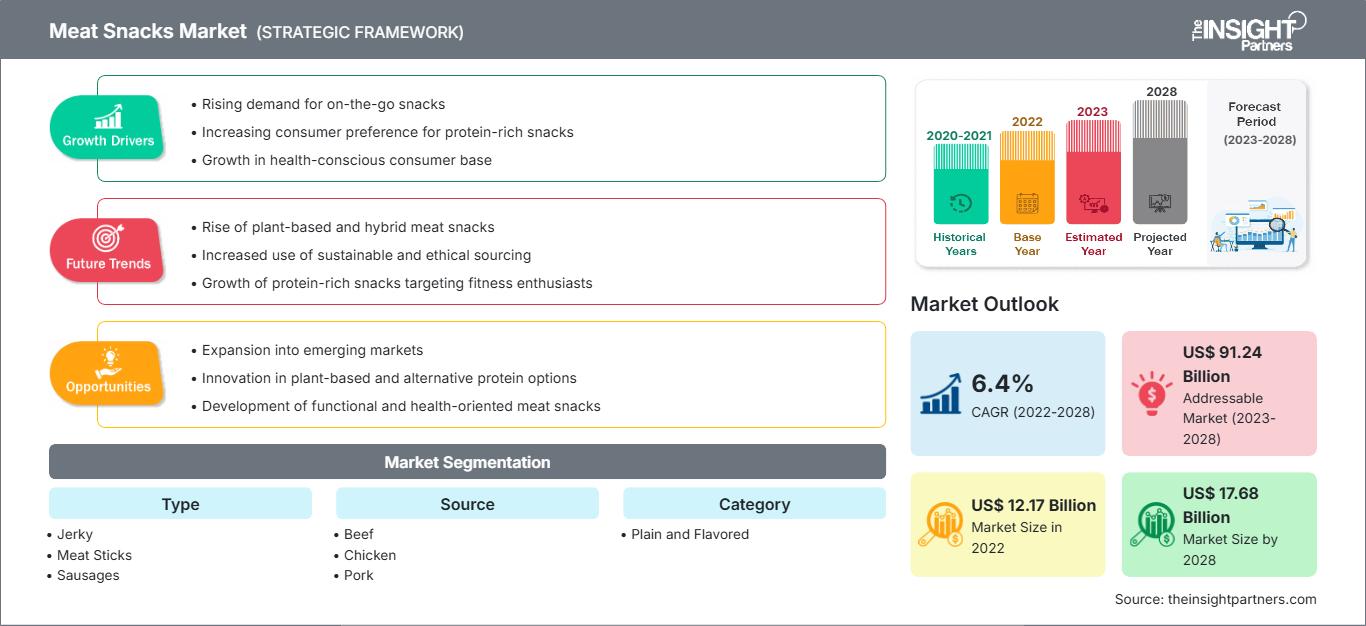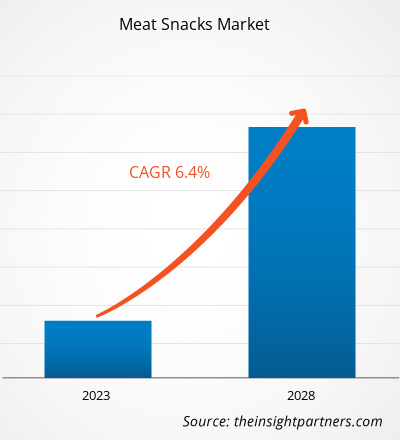[Forschungsbericht]Der Markt für Fleischsnacks soll von 12.169,01 Millionen US-Dollar im Jahr 2022 auf 12.169,01 Millionen US-Dollar wachsen; von 2022 bis 2028 wird ein CAGR von 6,4 % geschätzt.
Fleischsnacks erfreuen sich bei den Verbrauchern großer Beliebtheit, da sie reich an Proteinen, Eisen, Kreatin und verschiedenen Vitaminen sind. Zudem sind sie in einer Vielzahl von süßen und herzhaften Geschmacksrichtungen erhältlich, was ihre Nachfrage bei den Verbrauchern steigert. Derzeit werden die meisten fleischbasierten Snacks auf dem Markt aus Rind- oder Schweinefleisch hergestellt. Aufgrund des zunehmenden Gesundheits- und Wellnessbewusstseins greifen die Menschen jedoch zu magereren tierischen Proteinquellen. Rind-, Schweine- und Lammfleisch enthalten mehr gesättigte Fettsäuren als Hühnerfleisch. Aufgrund der zunehmenden Verbreitung von Fettleibigkeit und Herzerkrankungen bevorzugen Verbraucher fettarme Fleischprodukte. Dieser Faktor treibt die Nachfrage der Verbraucher nach Fleischsnacks auf Hühnerbasis an.
Im Jahr 2021 hatte Nordamerika den größten Anteil am Markt für Fleischsnacks, während der asiatisch-pazifische Raum im Prognosezeitraum voraussichtlich die höchste durchschnittliche jährliche Wachstumsrate verzeichnen wird. Geflügel- und Schweinefleisch sind im asiatisch-pazifischen Raum weit verbreitete Fleischsorten. Laut dem Nationalen Statistikamt stieg die Schweinefleischproduktion in China im Jahr 2021 gegenüber dem Vorjahr um 35,9 %. Darüber hinaus wächst die Geflügelindustrie in China, Indien, Japan und anderen Ländern des asiatisch-pazifischen Raums rasant, da die Nachfrage nach Geflügelfleisch deutlich steigt. Diese Faktoren werden voraussichtlich das Wachstum des Marktes für Fleischsnacks im asiatisch-pazifischen Raum im Prognosezeitraum vorantreiben.
Passen Sie diesen Bericht Ihren Anforderungen an
Sie erhalten kostenlos Anpassungen an jedem Bericht, einschließlich Teilen dieses Berichts oder einer Analyse auf Länderebene, eines Excel-Datenpakets sowie tolle Angebote und Rabatte für Start-ups und Universitäten.
Markt für Fleischsnacks: Strategische Einblicke

- Holen Sie sich die wichtigsten Markttrends aus diesem Bericht.Dieses KOSTENLOSE Beispiel umfasst Datenanalysen, die von Markttrends bis hin zu Schätzungen und Prognosen reichen.
Sie erhalten kostenlos Anpassungen an jedem Bericht, einschließlich Teilen dieses Berichts oder einer Analyse auf Länderebene, eines Excel-Datenpakets sowie tolle Angebote und Rabatte für Start-ups und Universitäten.
Markt für Fleischsnacks: Strategische Einblicke

- Holen Sie sich die wichtigsten Markttrends aus diesem Bericht.Dieses KOSTENLOSE Beispiel umfasst Datenanalysen, die von Markttrends bis hin zu Schätzungen und Prognosen reichen.
Auswirkungen der COVID-19-Pandemie auf den Markt für Fleischsnacks
Der Lebensmittel- und Getränkesektor sah sich aufgrund der COVID-19-Pandemie mit unerwarteten Herausforderungen konfrontiert. Staatliche Beschränkungen wie Lockdowns, Produktionsstilllegungen, Reiseverbote und Grenzbeschränkungen unterbrachen 2020 die globalen Lieferketten. Störungen in der Produktion und der Rohstoffbeschaffung bremsten das Wachstum des Marktes für Fleischsnacks in den ersten Monaten der Pandemie. Allerdings stieg die Nachfrage nach gefrorenen Fleischsnacks inmitten dieser globalen Krise aufgrund von Panikkäufen der Verbraucher. Verbraucher in Ländern wie den USA, Kanada, Deutschland und Großbritannien stellten ihre Ernährung drastisch auf pflanzliche Ernährung um. Einer Studie der Vegan Society zufolge hat jeder fünfte Brite seit Beginn der Pandemie seinen Fleischkonsum reduziert. Dieser Faktor bremste die Nachfrage nach Fleischsnacks. Im Jahr 2021 erholte sich der Markt, da die Regierungen Lockerungen zuvor verhängter Beschränkungen ankündigten und den Herstellern erlaubten, mit voller Kapazität zu arbeiten. So förderten höhere Produktionsmengen und verbesserte Lieferkettenabläufe das Wachstum des Marktes für Fleischsnacks. Die Pandemie hatte gemischte Auswirkungen auf den globalen Markt für Fleischsnacks.
Markteinblicke
Strategische Entwicklungen wichtiger Marktteilnehmer treiben den Markt für Fleischsnacks im Prognosezeitraum an
Unternehmen erweitern ihre Produktionskapazitäten, um die steigende Nachfrage nach Fleischsnacks weltweit zu decken. So investierte beispielsweise Jack Link’s, eine der führenden Marken für Fleischsnacks in den USA, im April 2022 450 Millionen US-Dollar in den Bau einer neuen Produktionsanlage in Georgia. Ebenso investierte Conagra Brands im Juli 2020 100 Millionen US-Dollar in die Erweiterung seiner Produktionsanlage für Fleischsnacks in Ohio, USA, um die steigende Nachfrage nach Slim Jim-Fleischprodukten und Duke’s Smoked Sausages zu decken. Solche Strategien dürften das Wachstum des Marktes für Fleischsnacks im Prognosezeitraum deutlich vorantreiben.
Typ-Einblicke
Basierend auf dem Typ ist der Markt für Fleischsnacks in Trockenfleisch, Fleischsticks, Würstchen und Sonstiges unterteilt. Das Segment Trockenfleisch hatte 2021 den größten Marktanteil. Allerdings wird erwartet, dass das Segment Fleischsticks von 2022 bis 2028 die höchste durchschnittliche jährliche Wachstumsrate verzeichnet. Jerkys sind die beliebtesten Fleischsnacks. Hersteller entwickeln gesündere Versionen von Jerky-Snacks, um den aufkommenden Gesundheitsbedenken der Verbraucher gerecht zu werden. So brachte beispielsweise der US-amerikanische Jerky- und Snackhersteller Werner Gourmet Meat Snacks im September 2019 ein neues Produkt in der Kategorie Fleischsnacks auf den Markt: ein zuckerfreies Jerky aus grasgefüttertem Rindfleisch. Es wird erwartet, dass solche Produkte bei den Verbrauchern enorm an Beliebtheit gewinnen, was das Wachstum des Marktes für Fleischsnacks im Prognosezeitraum ankurbeln dürfte.
Quelleninformationen
Der Quelle zufolge ist der Markt für Fleischsnacks in Rind-, Hühner-, Schweinefleisch und andere Sorten unterteilt. Das Segment Rindfleisch hatte 2021 den größten Marktanteil. Allerdings wird für das Hühnerfleischsegment im Prognosezeitraum die höchste durchschnittliche jährliche Wachstumsrate prognostiziert. Rind-, Schweine- und Lammfleisch enthalten mehr gesättigte Fettsäuren als Hühnerfleisch. Daher erhöht ein hoher Verzehr von Rind-, Schweine-, Lammfleisch und anderen Fleischsorten mit hohem Gehalt an gesättigten Fettsäuren den Cholesterinspiegel im Blut, was wiederum das Risiko für Herzkrankheiten, Fettleibigkeit und Bluthochdruck erhöht. Daher bevorzugen Verbraucher zunehmend Fleischprodukte auf Hühnerfleischbasis, um ihren Proteinbedarf zu decken und gleichzeitig die Kalorienzahl niedrig zu halten. Dieser Faktor dürfte das Marktwachstum im Hühnerfleischsegment in den kommenden Jahren vorantreiben.
Einblicke in Vertriebskanäle
Basierend auf den Vertriebskanälen ist der Markt für Fleischsnacks in Supermärkte und Hypermärkte, Convenience Stores, Online-Einzelhandel und andere segmentiert. Das Segment Supermärkte und Hypermärkte hatte 2021 den größten Marktanteil, während der Markt im Online-Einzelhandel im Prognosezeitraum voraussichtlich das schnellste Wachstum verzeichnen wird. Online-Einzelhandelsgeschäfte bieten verschiedene Produkte mit hohen Rabatten an. Außerdem können Verbraucher gewünschte Produkte bequem aus der Ferne über E-Commerce-Plattformen wie Amazon.com, Walmart und E-bay kaufen. Verbraucher bevorzugen für den Kauf von Fleischsnacks zunehmend Online-Einzelhandelsplattformen, da dort eine große Auswahl an Produkten verschiedener Marken zu ermäßigten Preisen und mit Hauslieferdiensten verfügbar ist. Dieser Faktor treibt das Marktwachstum im Online-Einzelhandelssegment voran.
Tyson Foods Inc, Bridgford Foods Corporation, General Mills Inc, Werner Gourmet Meat Snacks, Premium Brands, Hormel Foods Corporation, Conagra Brands Inc, Link Snacks Inc, Country Archer Provisions und Organic Valley gehören zu den wichtigsten Akteuren auf dem Markt für Fleischsnacks. Diese Unternehmen konzentrieren sich hauptsächlich auf Produktinnovationen, um ihren Marktanteil zu vergrößern und auf neue Markttrends zu reagieren. So brachte beispielsweise das spanische Unternehmen Noel Alimentaria im September 2020 unter der Marke „Picalos“ gesündere Fleischsnacks für unterwegs auf den Markt. Das Unternehmen setzte eine einzigartige Produktionstechnologie ein, bei der die Snacks langsam und handwerklich dehydriert und gebacken werden, wodurch die Nährstoffe des Fleisches erhalten bleiben. Es wird erwartet, dass solche Produkte im Prognosezeitraum bei den Verbrauchern großen Anklang finden werden.
Markt für Fleischsnacks
Die Analysten von The Insight Partners haben die regionalen Trends und Faktoren, die den Markt für Fleischsnacks im Prognosezeitraum beeinflussen, ausführlich erläutert. In diesem Abschnitt werden auch die Marktsegmente und die geografische Lage in Nordamerika, Europa, dem asiatisch-pazifischen Raum, dem Nahen Osten und Afrika sowie Süd- und Mittelamerika erörtert.Umfang des Marktberichts über Fleischsnacks
| Berichtsattribut | Einzelheiten |
|---|---|
| Marktgröße in 2022 | US$ 12.17 Billion |
| Marktgröße nach 2028 | US$ 17.68 Billion |
| Globale CAGR (2022 - 2028) | 6.4% |
| Historische Daten | 2020-2021 |
| Prognosezeitraum | 2023-2028 |
| Abgedeckte Segmente |
By Typ
|
| Abgedeckte Regionen und Länder | Nordamerika
|
| Marktführer und wichtige Unternehmensprofile |
|
Dichte der Marktteilnehmer für Fleischsnacks: Verständnis ihrer Auswirkungen auf die Geschäftsdynamik
Der Markt für Fleischsnacks wächst rasant, angetrieben von der steigenden Nachfrage der Endverbraucher aufgrund von Faktoren wie sich entwickelnden Verbraucherpräferenzen, technologischem Fortschritt und einem stärkeren Bewusstsein für die Produktvorteile. Mit steigender Nachfrage erweitern Unternehmen ihr Angebot, entwickeln Innovationen, um den Bedürfnissen der Verbraucher gerecht zu werden, und nutzen neue Trends, was das Marktwachstum weiter ankurbelt.

- Holen Sie sich die Markt für Fleischsnacks Übersicht der wichtigsten Akteure
Berichts-Spotlights
- Fortschreitende Branchentrends im Markt für Fleischsnacks, die Unternehmen bei der Entwicklung effektiver langfristiger Strategien unterstützen
- Geschäftswachstumsstrategien der Akteure des Marktes für Fleischsnacks in Industrie- und Entwicklungsländern
- Quantitative Analyse des Marktes von 2020 bis 2028
- Schätzung der weltweiten Nachfrage nach Fleischsnacks
- Porters Fünf-Kräfte-Analyse zur Veranschaulichung der Wirksamkeit von Käufern und Lieferanten im Markt für Fleischsnacks
- Jüngste Entwicklungen zum Verständnis des wettbewerbsorientierten Marktszenarios
- Markttrends und -aussichten sowie Faktoren, die das Wachstum des Marktes für Fleischsnacks fördern und hemmen
- Unterstützung im Entscheidungsprozess durch Hervorhebung von Marktstrategien, die das kommerzielle Interesse untermauern
- Größe des Marktes für Fleischsnacks an verschiedenen Knotenpunkten
- Detaillierte Übersicht und Segmentierung des Marktes sowie der Fleischsnackbranche Dynamik
- Größe des Marktes für Fleischsnacks in verschiedenen Regionen mit vielversprechenden Wachstumschancen
- Historische Analyse (2 Jahre), Basisjahr, Prognose (7 Jahre) mit CAGR
- PEST- und SWOT-Analyse
- Marktgröße Wert/Volumen – Global, Regional, Land
- Branchen- und Wettbewerbslandschaft
- Excel-Datensatz
Aktuelle Berichte
Verwandte Berichte
Erfahrungsberichte
Grund zum Kauf
- Fundierte Entscheidungsfindung
- Marktdynamik verstehen
- Wettbewerbsanalyse
- Kundeneinblicke
- Marktprognosen
- Risikominimierung
- Strategische Planung
- Investitionsbegründung
- Identifizierung neuer Märkte
- Verbesserung von Marketingstrategien
- Steigerung der Betriebseffizienz
- Anpassung an regulatorische Trends






















 Kostenlose Probe anfordern für - Markt für Fleischsnacks
Kostenlose Probe anfordern für - Markt für Fleischsnacks